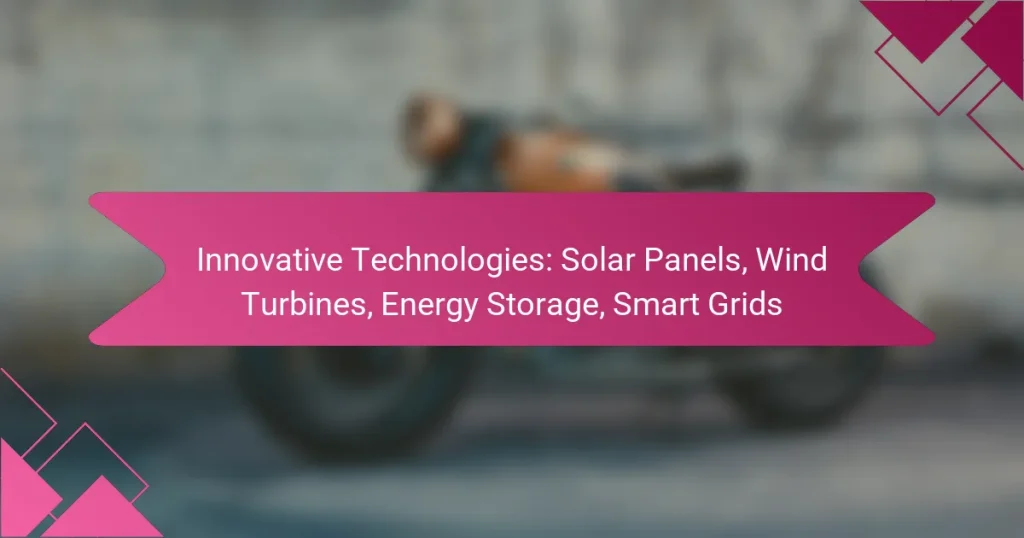Innovative technologies such as solar panels, wind turbines, energy storage solutions, and smart grids are transforming the landscape of renewable energy. Solar panels provide cost savings and environmental benefits, while wind turbines efficiently convert wind energy into electricity. Energy storage technologies ensure reliability by storing energy for later use, and smart grids enhance the management and distribution of this energy, creating a more sustainable and resilient energy system.
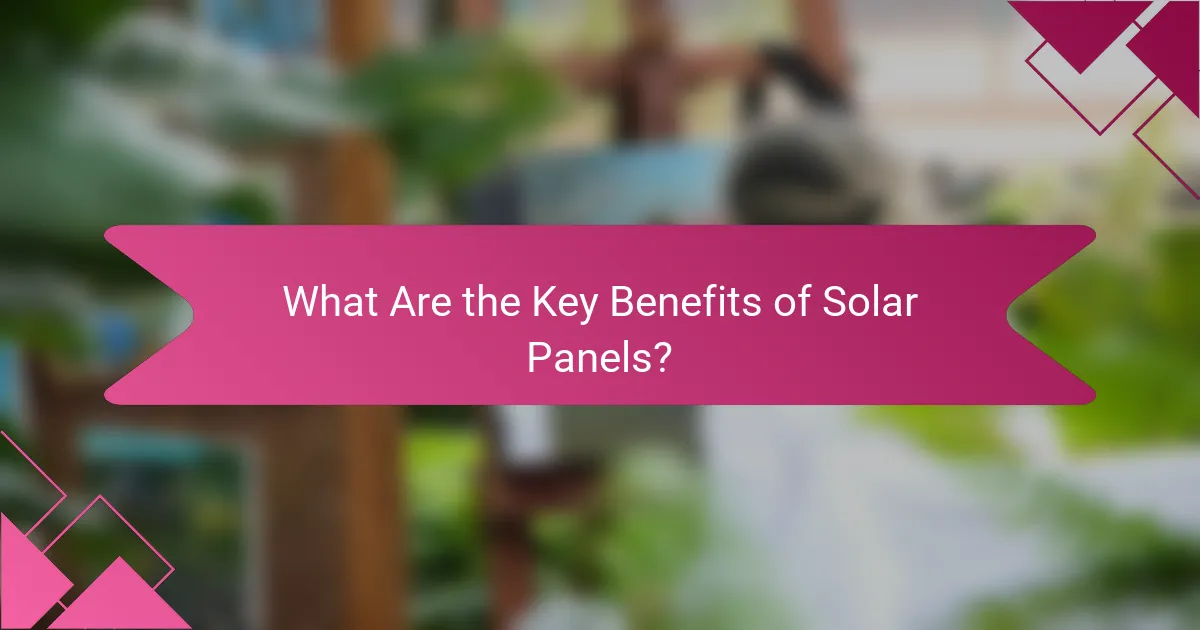
What Are the Key Benefits of Solar Panels?
Solar panels offer numerous benefits, including significant cost savings on electricity, reduced environmental impact, and increased energy independence. They also enhance property values and require minimal maintenance, making them an attractive option for homeowners and businesses alike.
Cost savings on electricity
One of the primary advantages of solar panels is the potential for substantial savings on electricity bills. By generating your own power, you can significantly reduce or even eliminate your monthly energy costs, depending on your system size and energy usage.
In many regions, net metering policies allow you to sell excess energy back to the grid, further enhancing savings. Over time, the initial investment in solar panels can pay for itself, often within a decade, leading to long-term financial benefits.
Environmental impact reduction
Solar panels contribute to a cleaner environment by reducing reliance on fossil fuels, which are major contributors to air pollution and climate change. By harnessing renewable energy from the sun, solar systems produce electricity without emitting greenhouse gases.
Switching to solar can significantly lower your carbon footprint. For instance, a typical residential solar system can offset several tons of carbon dioxide emissions annually, making a positive impact on the planet.
Energy independence
Solar panels provide a pathway to energy independence by allowing homeowners and businesses to generate their own electricity. This reduces reliance on utility companies and protects against fluctuating energy prices.
By investing in solar energy, you can gain more control over your energy supply, ensuring a stable and predictable energy source. In areas prone to power outages, solar systems paired with energy storage solutions can enhance resilience and reliability.
Increased property value
Installing solar panels can increase the value of your property. Homes with solar energy systems often sell for more than comparable homes without them, as buyers are increasingly looking for energy-efficient features.
Real estate studies have shown that properties with solar installations can see an increase in value ranging from 3% to 4% or more, depending on the local market and energy savings potential. This makes solar panels not just an energy solution but also a smart investment.
Low maintenance requirements
Solar panels are known for their low maintenance needs, making them a hassle-free energy solution. Most systems only require periodic cleaning and an occasional inspection to ensure optimal performance.
With no moving parts, solar panels are durable and can last 25 years or more with minimal upkeep. Many manufacturers offer warranties that cover performance and equipment, providing peace of mind for homeowners and businesses alike.

How Do Wind Turbines Generate Electricity?
Wind turbines generate electricity by converting the kinetic energy of wind into mechanical energy, which is then transformed into electrical energy through a generator. This process involves several key components working together efficiently to harness wind power effectively.
Conversion of wind energy to mechanical energy
The first step in generating electricity with wind turbines is the conversion of wind energy into mechanical energy. As wind flows over the turbine blades, it creates lift, causing the blades to rotate. This rotation is crucial as it drives the turbine’s rotor, which is connected to a shaft.
The amount of mechanical energy produced depends on factors such as wind speed and blade design. Generally, turbines start generating power at wind speeds of around 3 to 5 meters per second and reach their maximum efficiency at speeds between 12 to 15 meters per second.
Use of generators for electricity production
Once the rotor is spinning, it turns a generator that converts mechanical energy into electrical energy. Most modern wind turbines use either synchronous or asynchronous generators. Synchronous generators maintain a constant speed, while asynchronous generators can vary their speed based on wind conditions.
The electricity produced is typically alternating current (AC), which can be transformed to higher voltages for transmission through power lines. This conversion is essential for integrating wind energy into the electrical grid.
Importance of turbine design
Turbine design plays a critical role in the efficiency and effectiveness of electricity generation. Factors such as blade length, shape, and material directly influence how well a turbine can capture wind energy. Longer blades can capture more wind, but they also require stronger materials to withstand high winds.
Additionally, the height of the turbine tower is significant. Taller towers can access higher wind speeds, which can lead to increased energy production. Therefore, careful consideration of design elements is vital for optimizing performance and maximizing energy output.

What Are the Best Energy Storage Solutions?
The best energy storage solutions include technologies that effectively store energy for later use, enabling a more reliable and efficient energy system. Key options include lithium-ion batteries, flow batteries, pumped hydro storage, and their applications in renewable energy systems.
Lithium-ion batteries
Lithium-ion batteries are widely used for energy storage due to their high energy density and efficiency. They work by moving lithium ions between the anode and cathode during charging and discharging, allowing for quick energy release and recharge times.
These batteries are commonly found in consumer electronics, electric vehicles, and grid storage applications. When considering lithium-ion batteries, factors such as lifespan, cost (typically ranging from $200 to $600 per kWh), and environmental impact should be evaluated.
Flow batteries
Flow batteries are an innovative energy storage technology that uses liquid electrolytes to store energy. They operate by circulating these electrolytes through a cell stack, allowing for scalable energy storage capacity based on the size of the tanks used.
Flow batteries are particularly suited for large-scale applications, such as renewable energy integration and grid stabilization. Their advantages include longer cycle life and the ability to discharge energy over extended periods, although they tend to have lower energy density compared to lithium-ion batteries.
Pumped hydro storage
Pumped hydro storage is a mature and widely used method for large-scale energy storage. It involves pumping water to a higher elevation during periods of low energy demand and releasing it to generate electricity during peak demand.
This technology can provide significant storage capacity, often in the range of hundreds of megawatt-hours. However, it requires specific geographical conditions and substantial initial investment, making it less flexible than other storage options.
Applications in renewable energy
Energy storage solutions play a crucial role in enhancing the reliability of renewable energy sources like solar and wind. By storing excess energy generated during peak production times, these technologies help balance supply and demand, ensuring a stable energy supply.
For instance, integrating lithium-ion batteries with solar panels allows homeowners to store energy for nighttime use, while pumped hydro storage can help manage fluctuations in wind energy production. Selecting the right storage solution depends on factors such as project scale, budget, and specific energy needs.
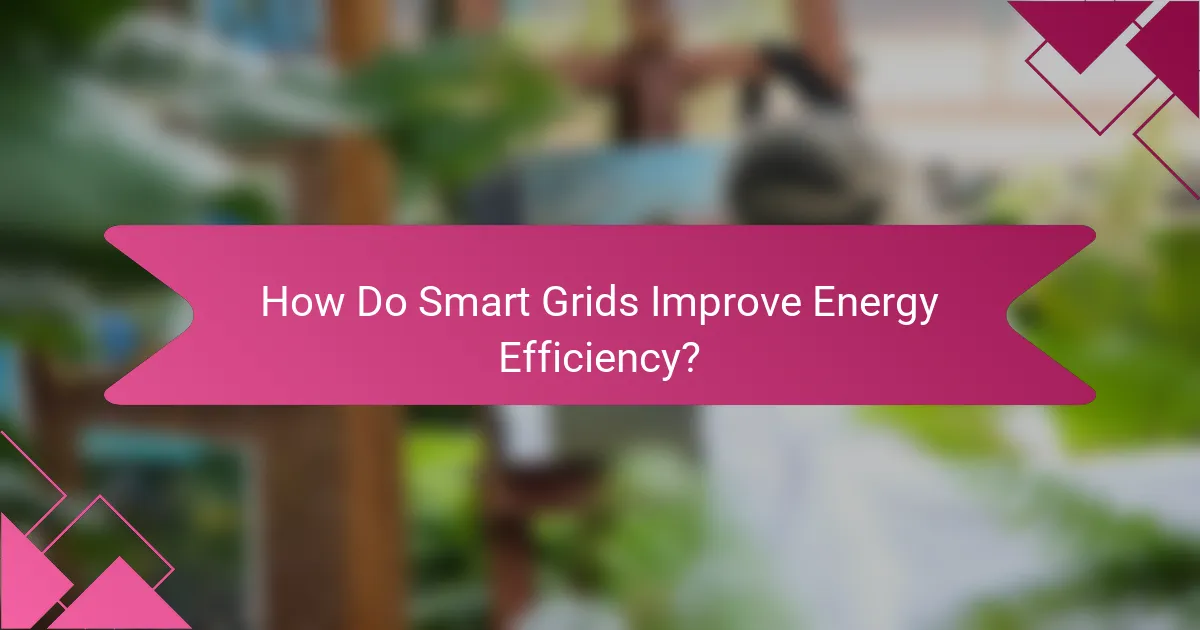
How Do Smart Grids Improve Energy Efficiency?
Smart grids enhance energy efficiency by utilizing advanced technology to monitor and manage electricity flow in real-time. This leads to optimized energy distribution, reduced waste, and increased integration of renewable energy sources.
Real-time energy monitoring
Real-time energy monitoring allows utilities and consumers to track energy usage instantaneously. This capability helps identify peak usage times and adjust consumption accordingly, which can lead to significant cost savings.
For example, households can receive alerts when energy usage spikes, prompting them to reduce consumption during high-cost periods. This proactive approach can lower monthly bills and enhance overall energy efficiency.
Integration of renewable energy sources
Smart grids facilitate the integration of renewable energy sources, such as solar and wind, into the existing power infrastructure. By managing the variable output of these sources, smart grids ensure a more stable and reliable energy supply.
Utilities can better balance energy demand with supply from renewables, reducing reliance on fossil fuels and lowering greenhouse gas emissions. This integration is crucial for meeting renewable energy targets set by local regulations.
Enhanced grid reliability
Enhanced grid reliability is achieved through smart grid technologies that detect and respond to outages quickly. Automated systems can reroute power and minimize downtime, ensuring a consistent energy supply for consumers.
Additionally, predictive maintenance techniques can identify potential issues before they lead to failures, further increasing reliability. This proactive management helps maintain service quality and reduces the economic impact of outages on businesses and households.
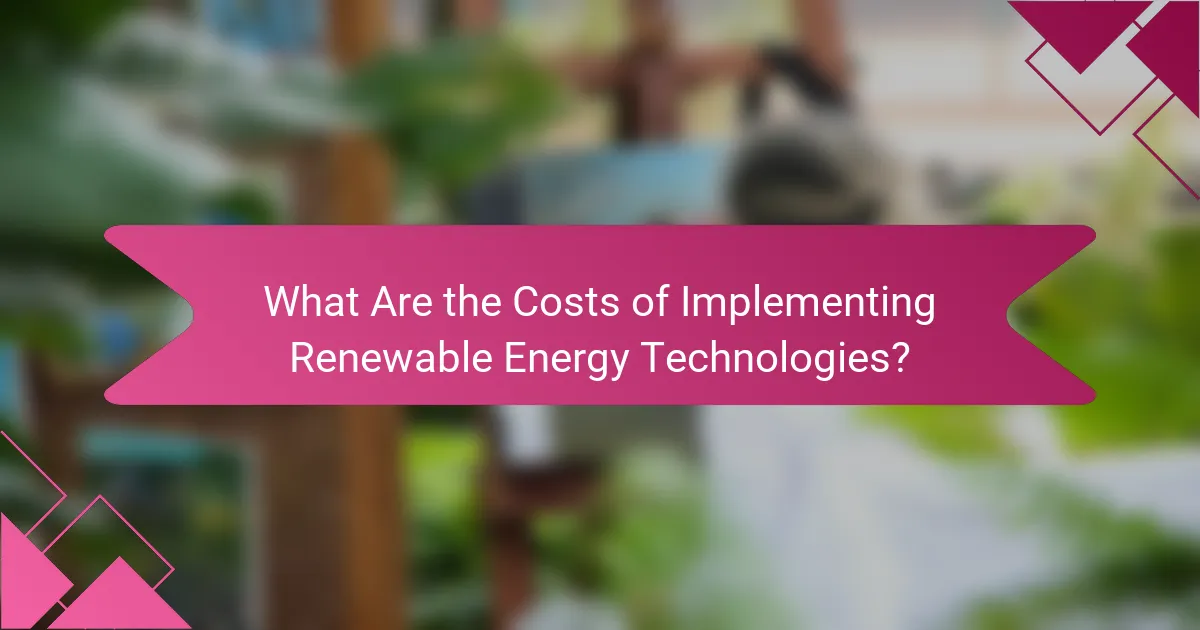
What Are the Costs of Implementing Renewable Energy Technologies?
The costs of implementing renewable energy technologies vary widely depending on the type of technology, location, and scale of the project. Understanding the initial investments and potential long-term savings is crucial for making informed decisions.
Initial investment for solar panels
The initial investment for solar panels typically ranges from several thousand to tens of thousands of dollars, depending on the system size and installation specifics. For residential systems in the U.S., costs can average around $15,000 to $25,000 before incentives.
Factors influencing the cost include the type of solar panels, inverter systems, and installation complexity. Additionally, local incentives and tax credits can significantly reduce upfront expenses.
Installation costs for wind turbines
Installation costs for wind turbines can vary significantly based on the turbine size and location. Small residential turbines may cost between $10,000 and $50,000, while larger commercial installations can reach hundreds of thousands to millions of dollars.
Considerations include site assessment, permitting, and grid connection fees. It’s essential to evaluate local wind resources and regulations to determine feasibility and potential return on investment.
Long-term savings analysis
Long-term savings from renewable energy technologies can be substantial, often leading to reduced energy bills and increased property value. Homeowners may save thousands over 20-30 years, depending on energy prices and system performance.
When analyzing savings, consider factors such as maintenance costs, energy efficiency improvements, and potential income from selling excess energy back to the grid. Conducting a thorough financial analysis can help clarify the overall economic benefits of renewable energy investments.
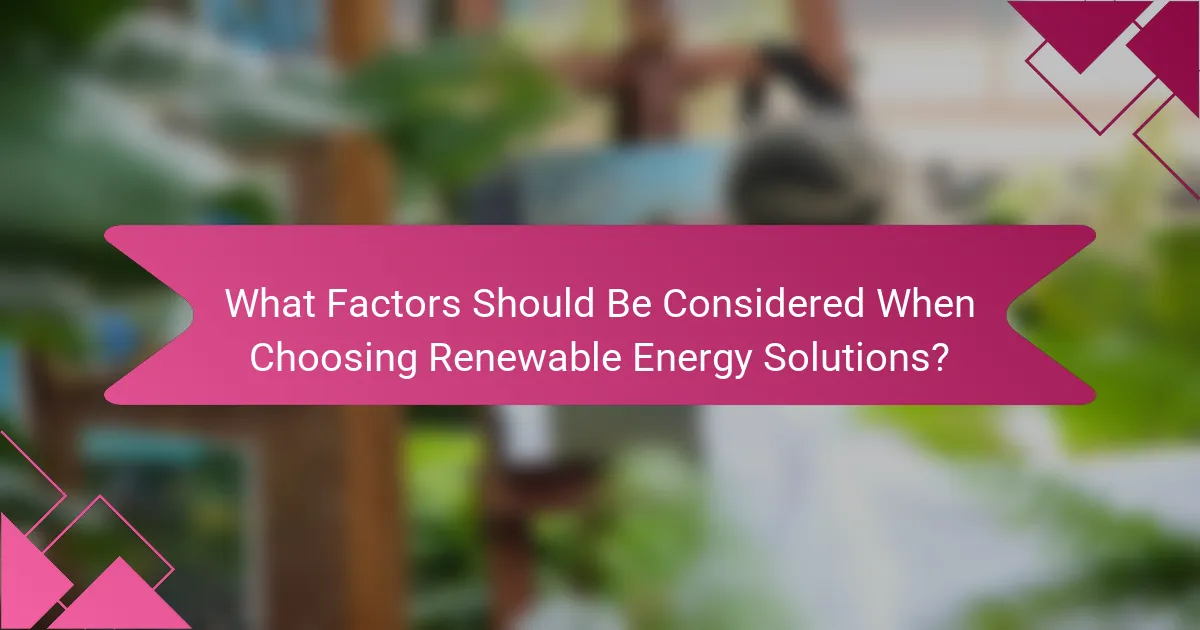
What Factors Should Be Considered When Choosing Renewable Energy Solutions?
When selecting renewable energy solutions, key factors include energy needs, location, budget, and available technology. Understanding these elements helps in making informed decisions that align with both environmental goals and financial constraints.
Energy Needs and Consumption Patterns
Assessing energy needs is crucial when choosing renewable solutions. Consider your current energy consumption patterns, peak usage times, and future growth. This analysis helps determine the size and type of system required, whether it be solar panels, wind turbines, or a combination of both.
For instance, a household with high energy demands may benefit from a larger solar array or a hybrid system that incorporates wind energy. Evaluating your energy profile can guide you in selecting the most efficient and cost-effective solution.
Location and Climate Considerations
Your geographical location significantly impacts the effectiveness of renewable energy technologies. Solar panels perform best in sunny regions, while wind turbines are more effective in areas with consistent wind patterns. Understanding local climate conditions can help optimize energy production.
For example, if you live in a coastal area with high winds, investing in wind energy may yield better returns than solar. Conversely, regions with abundant sunlight may find solar panels to be the most viable option.
Budget and Financial Incentives
Budget constraints play a vital role in choosing renewable energy solutions. Consider not only the initial investment but also long-term savings on energy bills. Research available financial incentives, such as tax credits or rebates, which can significantly reduce upfront costs.
In the United States, for instance, the federal solar tax credit allows homeowners to deduct a percentage of the installation costs from their federal taxes. Understanding these financial aspects can help you make a more informed decision.
Technology and System Compatibility
Different renewable energy technologies have varying compatibility with existing systems. For example, if you already have an electric grid connection, integrating solar panels may be straightforward. However, if you opt for off-grid solutions, additional considerations for energy storage and backup systems will be necessary.
Before making a decision, evaluate how the chosen technology will integrate with your current infrastructure. This assessment can prevent costly modifications and ensure a smoother implementation process.
Regulatory and Environmental Impact
Understanding local regulations and environmental impacts is essential when selecting renewable energy solutions. Some areas may have specific zoning laws or permits required for installation. Additionally, consider the environmental footprint of the technology you choose.
For example, while solar panels have minimal environmental impact during operation, the manufacturing process can be resource-intensive. Researching these factors can help you choose a solution that aligns with both regulatory requirements and sustainability goals.
